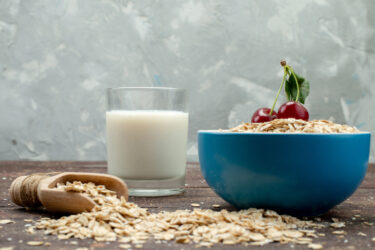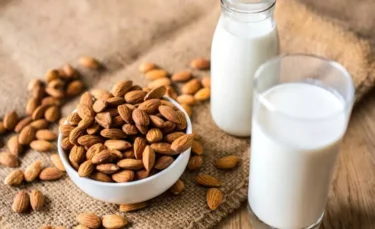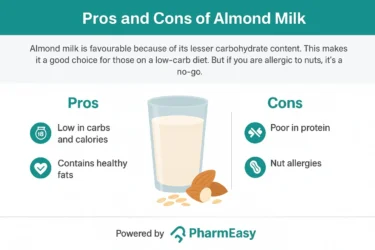Oat Milk vs Almond Milk: Which is More Nutritious?
By Dr. Malavika Athavale +2 more

Get,

to manage your symptom
Get your,


4 Cr+ families
benefitted

OTP sent to 9988776655



You’ve successfully subscribed to receive
doctor-approved tips on
Whatsapp

Get ready to feel your best.

Hi There,
Download the PharmEasy App now!!


Register to Avail the Offer
Send OTPBy continuing, you agree with our Privacy Policy and Terms and Conditions

Hi There,
Sign up on PharmEasy now!!
Trusted by 4 crore+ families

OTP sent to 9988776655



You have unlocked 25% off on medicines




Code: NU25
By Dr. Malavika Athavale +2 more
Table of Contents
Are you aware of the buzz about oat milk and almond milk? These plant-based milk options have become very popular recently, especially for those who want to avoid dairy. This blog discusses in detail about these newer milk options. We’ll explore their nutritional facts, weigh their good and bad sides, evaluate their green credentials and safety concerns.


Oat milk is a non-dairy option made by blending soaked oats with water and filtering out the pulp. The result is a delicious, creamy drink that’s taken the plant milk world by storm.
Making oat milk is simple. You start by grinding whole oats, stirring them into water, and heating the mix. This process splits the oat starches. The liquid is separated from the oat mush and filtered. The end result is a thick creamy milk packed with fibres, especially beta-glucans.
Unlike some plant milks, oat milk boasts a smooth, buttery texture. It’s almost as rich as full-fat dairy milk. As for taste, oat milk is naturally sweet with a subtle oaty aftertaste. That’s why it is so popular in creamy dishes.

Now let’s check out almond milk. This non-dairy favourite has origins dating back to medieval times. It’s made mostly from almonds and water. Its mild texture and slightly nutty flavour have earned it many fans.
How do we make almond milk? First, we soak almonds in water overnight. Next, we drain the almonds and blend them with more water. Finally, we strain the mixture to remove the solids. What remains is a silky, pale milky-white liquid.
Almond milk has a light, thin consistency with a hint of nuttiness. Unsweetened versions are less calorie-dense. That’s why it’s popular among diet watchers and health buffs.
Though oat milk and almond milk are top-notch non-dairy options, their nutritional profiles can be quite different. These differences matter when picking one over the other.
Based on what I have observed, almond and oat milk are popular choices for non-dairy alternatives in India. These plant-based milk alternatives are often chosen by individuals who are lactose intolerant, have dairy allergies, or follow a vegan diet. The consumption of almond milk in India was found to be about 54% as compared to oat milk, which was about 29%9.
Dr. Siddharth Gupta, B.A.M.S, M.D (Ayu)
Apart from being lactose-free and vegan, oat milk and almond milk offer unique health perks tied to their ingredients. However, there are some drawbacks of both.

Oat milk is tasty and packed with nutrients, making it a great non-dairy milk stand-in, especially for individuals allergic to tree nuts.
From what I have observed, a 240ml serving of oat milk contains approximately 130 calories, 24g of carbohydrates, 4g of proteins, and 2.5g of fats. Oat milk can be a suitable option for those looking for a plant-based alternative to dairy milk, providing essential nutrients in a convenient form9.
Dr. Rajeev Singh, BAMS

Almond milk is favourable because of its lesser carbohydrate content. This makes it a good choice for those on a low-carb diet. But if you are allergic to nuts, it’s a no-go.
Almond and oat milk offer different levels of nutrient richness. Almond milk has fewer calories, but it also provides less protein, carbs, and fibre. On the other hand, oat milk has more calories, but it also provides more of these vital nutrients.
Oat milk generally contains more added B vitamins than almond milk, and almond milk contains more vitamin E.7 However, both fortified almond and oat milks have the necessary vitamins and minerals like vitamin D and calcium. But remember, not all fortified brands are equal. Some may include thickening agents, artificial flavours, and excessive salt. So beware when you buy.
Oat milk has about 120 calories per cup, which is almost three times the calories in almond milk. Almond milk has just 37 calories per cup. For those counting calories, almond milk might be a better option1,2.
Oat milk has higher protein that is about 3 grams per cup. Almond milk trails with 1.5 grams per cup1,2. But cow’s milk has much higher protein that both, that is about 8 grams of protein per cup.8 In terms of carbs, oat milk is the clear winner with 16 grams per cup. Almond milk has just one gram per cup. As for fat, almond milk has more than oat milk1,2.
Based on what I have read, a 240ml serving of almond milk typically contains around 59 calories, 6g of carbohydrates, 1g of protein, and 4g of fats. These nutritional values make almond milk a viable option for individuals who are lactose intolerant or follow a plant-based diet9.
Dr. Smita Barode, B.A.M.S, M.S.
Both oat milk and almond milk leave a mark on the environment. Here we’ll explore water use, carbon emissions, and energy use in making these milks.
Think about allergies, additives, and sugar when thinking about safety.
Some people are allergic to almonds, so there’s a risk with almond milk. Oat milk could indirectly trigger allergies. This happens through possible gluten contamination. Those allergic to gluten need to be careful here and opt for gluten-free options.
Many varieties of oats and almond milk use things like gums to tweak their consistency and shelf life. Usually, these are safe. However, studies suggest that eating too much might mess up your digestion. Some almond milk brands use carrageenan, which has links to digestive troubles and gut inflammation.
Sugar content in these milks can vary a lot across brands. Unflavoured, unsweetened types have very little sugar, but flavoured types can be high in sugar. Always read the nutrition label to avoid extra added sugars.
Choosing between oat milk and almond milk rests mainly on personal taste, dietary needs, and green concerns.
If you’re trying to lose weight or if you’re diabetic, almond milk might be a good choice due to its low calorie and carb content. But if you’re looking to manage cholesterol or want a filling drink, oat milk wins due to its high fibre content.
Whether you prefer the creaminess of oat milk or the nuttier taste of almond milk guides your everyday choice.
If you’re looking for an eco-friendly option, oat milk wins hands down. It uses less water, land, and emits less CO2 during production.
Also Read: Goat Milk: Benefits, Uses, Side Effects & More!
In this blog post, we’ve dug deep into oat milk and almond milk. Both have a rightful place in the dairy-free movement. Both have their strengths. Almond milk wins with fewer calories, oat milk scores with higher fibre. One thing to note is that neither oat milk nor almond milk reach the protein content of cow’s milk. But you can get calcium, vitamin D, and vitamin B12 from fortified oat and almond milk versions.We didn’t intend to pit one milk against the other. Rather, we’ve tried to give you a clear picture of the pros and cons of each. Remember, the ultimate goal isn’t to find the ‘best’ milk, but to find the milk that’s ‘best for you’.
Also Read: Almond Milk: Uses, Benefits, Side Effects by Dr. Rajeev Singh
It depends. If you’re aiming to lose weight or are diabetic, almond milk with its lower sugar and calorie content might be right for you. On the other hand , oat milk is high in fibre and nutrients, which boosts heart health and immunity, and helps muscle grow. Consult a health professional for tailored advice.
Different types of milk suit different people. Each has its unique set of nutrients and caters to different diet needs or restrictions. Oat milk is as creamy as cow’s milk, but it provides less protein and more sugar. Cow’s milk offers protein and calcium but might trigger allergies. The ‘healthiest’ milk is the one that matches your particular health goals.
Both are suitable. Both oat milk and almond milk do not contain lactose. So, both are safe for individuals who are lactose intolerant or choose to avoid dairy.
Oat milk and almond milk both have low calorie options, but almond milk generally has fewer calories, making it a better choice for weight loss. However, the best option depends on individual nutritional needs and preferences.
Almond milk is better for managing cholesterol as it contains no cholesterol and is low in saturated fat. Oat milk, while slightly higher in calories, also helps lower cholesterol due to its beta-glucan fibre content.
Almond milk is generally better for diabetics because it has a lower carbohydrate content and glycaemic index compared to oat milk. However, unsweetened varieties of both can be suitable depending on individual dietary needs.
Almond milk tends to blend well with coffee without overpowering its flavour, while oat milk offers a creamier texture and natural sweetness that some prefer. The best choice depends on personal taste preferences and desired coffee experience.
Disclaimer: The information provided here is for educational/awareness purposes only and is not intended to be a substitute for medical treatment by a healthcare professional and should not be relied upon to diagnose or treat any medical condition. The reader should consult a registered medical practitioner to determine the appropriateness of the information and before consuming any medication. PharmEasy does not provide any guarantee or warranty (express or implied) regarding the accuracy, adequacy, completeness, legality, reliability or usefulness of the information; and disclaims any liability arising thereof.
Links and product recommendations in the information provided here are advertisements of third-party products available on the website. PharmEasy does not make any representation on the accuracy or suitability of such products/services. Advertisements do not influence the editorial decisions or content. The information in this blog is subject to change without notice. The authors and administrators reserve the right to modify, add, or remove content without notification. It is your responsibility to review this disclaimer regularly for any changes.
Comments

Leave your comment...
You may also like
Comments